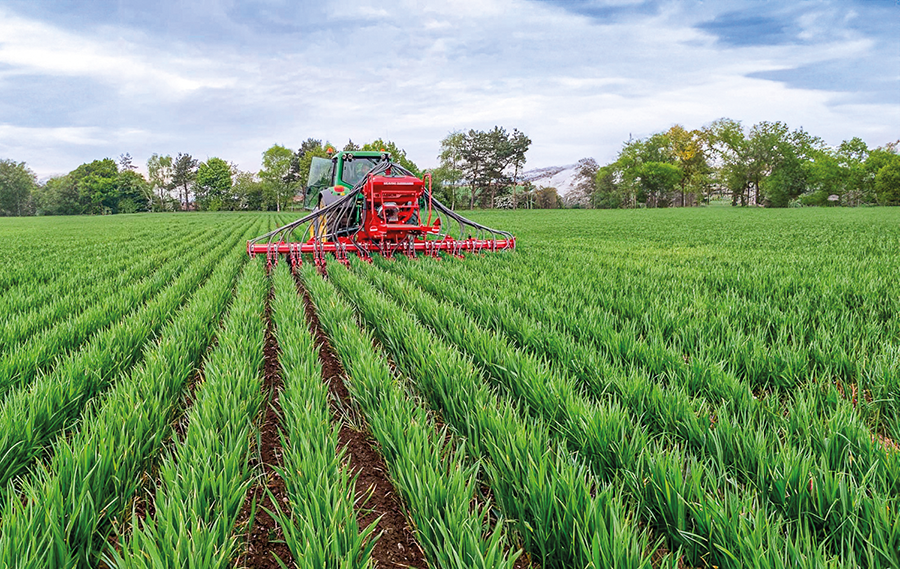Inter-row drill investment aids move to more sustainable farming
8th February 2024
A Shropshire family farm is making a gradual move to regenerative farming and improved soil health with the help of a Weaving IR (inter-row) drill. David Williams reports.

Trading as JM Bubb & Son, the Bubb family farms approximately 800ha of predominantly sandy loam soils at South Lynn Farm, near Newport. Potatoes are the main arable crop, grown every six years within an extended rotation which also includes three crops of wheat alternating with oilseed rape and flowers. As well as conventional cereals, the farm also grows crops for Wild Farmed using reduced fertiliser applications and no pesticides.
Flowers are grown for the family’s established Shropshire Petals business. The flowers are picked and hand-packed on-site, before being sold online for display or use as environmentally friendly confetti, worldwide.
Prioritising plant and soil health
“Growing potatoes involves deep cultivations, but for the rest of the rotation we have reduced tillage to be more sustainable and to improve soil health,” said John Bubb. “At the same time, we are trying to reduce applications of artificial fertilisers and pesticides, and by planting in wider-spaced crops we create better air flow around the plants, reducing opportunities for fungal disease development, transmission and spread.”
Living mulch trials
Clover is being trialled as a living mulch, seeded between the crop rows and remaining as a ley for the five-year rotation. Wheat is planted in paired rows at 15cm spacing using an older adapted Weaving Tine Drill. The pairs of rows are 50cm apart, with the clover drilled in two rows in-between by the new Weaving inter-row drill. Oilseed rape and flowers are established using a precision drill.
The clover is cut in April to keep growth in check, and it provides a natural source of nitrogen for the growing cash crops. The arable crops are harvested as usual, then the stubble rows are shallow tilled using a strip-till cultivator ready for the next crop, while the clover remains in place. Every sixth year the whole field is deep cultivated in preparation for potatoes and the rotation starts again.
Early stages
John stressed that the technique, now in its second full season, remains a trial on the farm. “Every season is different so comparisons are difficult, but the first year our clover germinated and then died off before it could establish due to the exceptionally dry conditions. Last year we took precautions to prevent a repeat by irrigating after drilling and improve early growth. It proved very successful, and the crops are looking good.
Other issues encountered using the technique include the clover’s tendency to spread into crop rows. This is countered by trimming excessive foliage, which is separated from the plant by a cutter with vertical discs.
Optimised conditions
John commented that the Weaving IR drill is ideal for the task. Mounted to the tractor linkage means accurate row spacing is maintained through the tractor’s GPS guidance, and the coulter and press wheel arrangement creates ideal conditions for the clover to establish, while ensuring effective soil-to-seed contact and retaining soil moisture. “I did look at what else was available, but felt the Weaving design was the best. I think it’s important to support UK-based manufacturers too,” he confirmed.
Effective design
The Weaving Mounted IR Drill is designed for inter-row establishment of companion crops including grass seed and cover crops. The primary requirement during development was for planting cover crops between maize rows, but the versatile drill is proving popular for a range of other applications too.
Seeds are placed at consistent depth by a double-disc coulter and press wheel. The seeding system is simple and effective, and suitable for direct drilling as well as operating in min-till establishment regimes. Hydraulic side-shift and adaptable row spacing allows use with different tractor wheel spacings and crops. The Accord metering system can be used for fine and coarse grains drilled at rates from 1.8–400kg/ha, and the hydraulic-driven distribution fan has a low power demand.
Endless possibilities
John said that although wider spaced rows mean lower cash crop plant populations and yields, he expects margins to be higher. “We use less seed, less fertiliser and less chemical and are moving less soil during cultivations, so our costs are significantly lower,” he said. “But the most important thing for us is that we farm sustainably using less artificial fertiliser and chemicals, while maximising soil health for the future. Part of that is always looking at new ways to diversify in terms of our crops and crop establishment techniques. Last year we started trials of DeCyst to reduce potato cyst nematode populations. This was drilled with the clover, and we hope it will provide a natural solution, reducing the need for pesticides. We are in the early stages of our trials using inter-row cropping techniques, but I believe the possibilities are endless.”
Read more machinery news here


